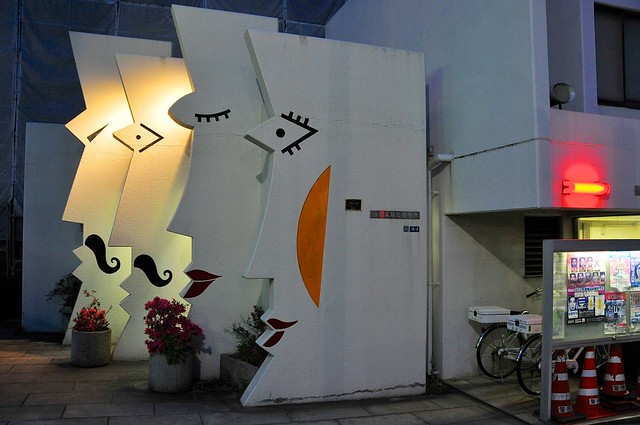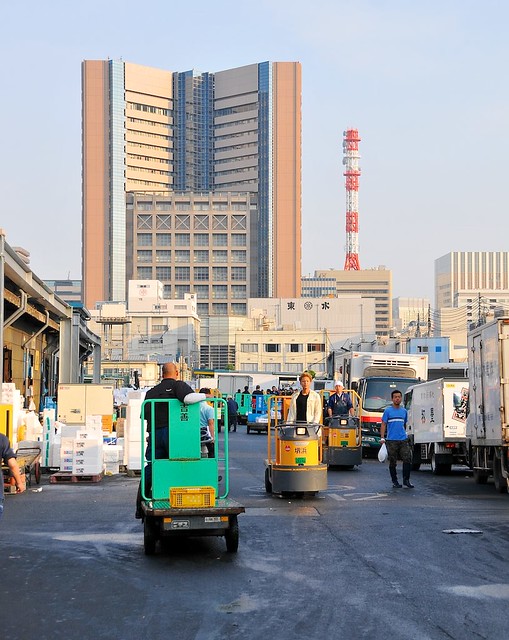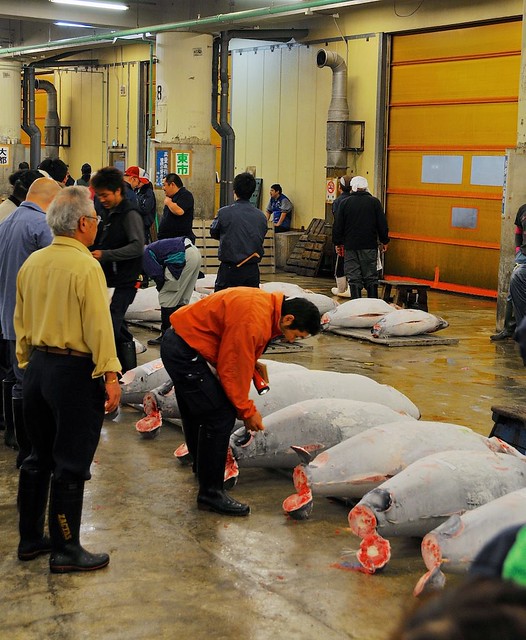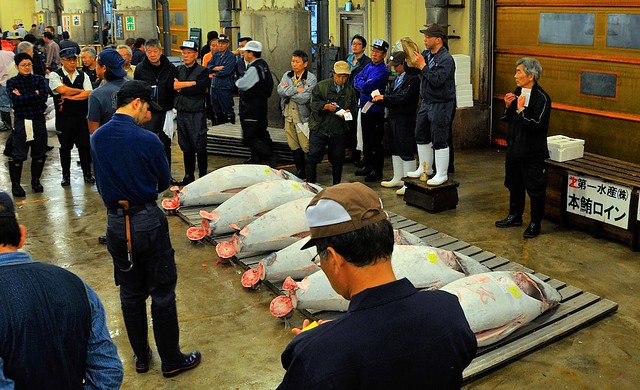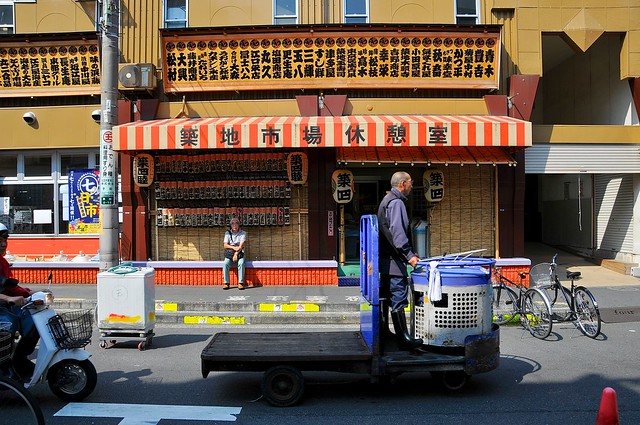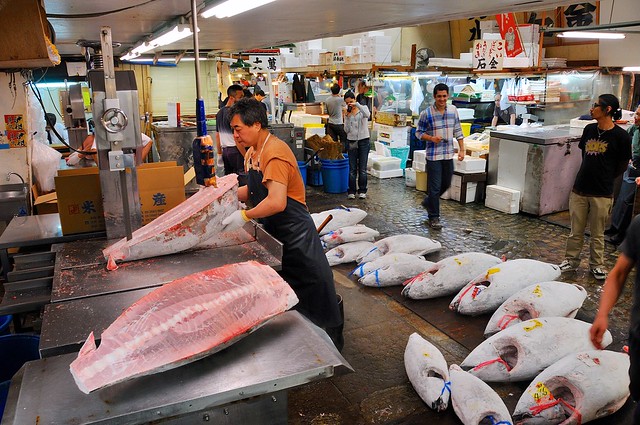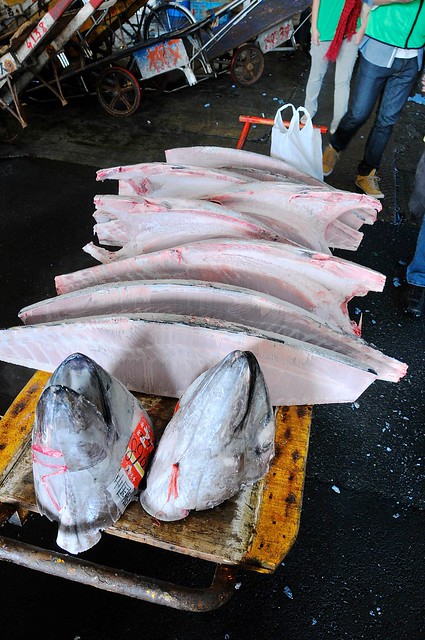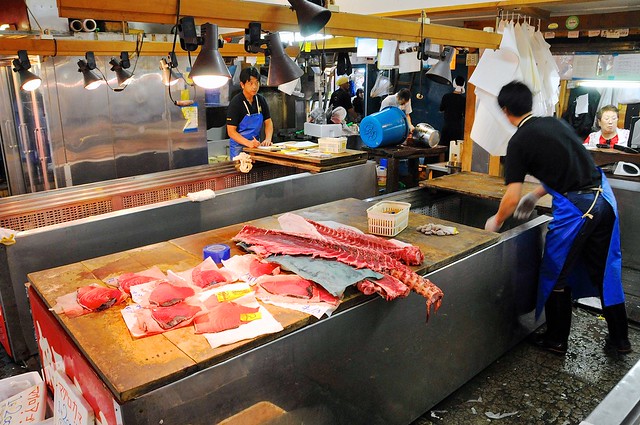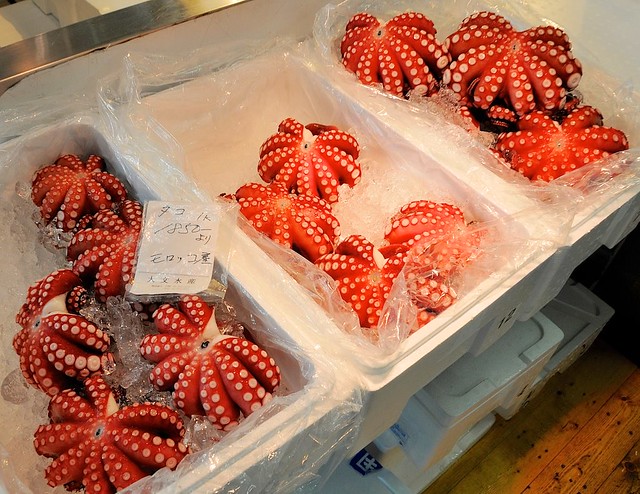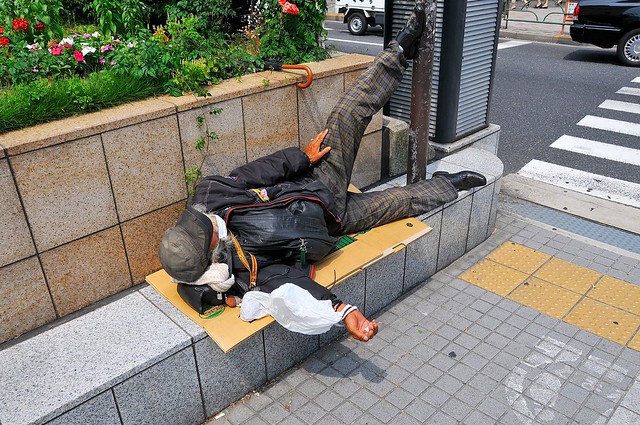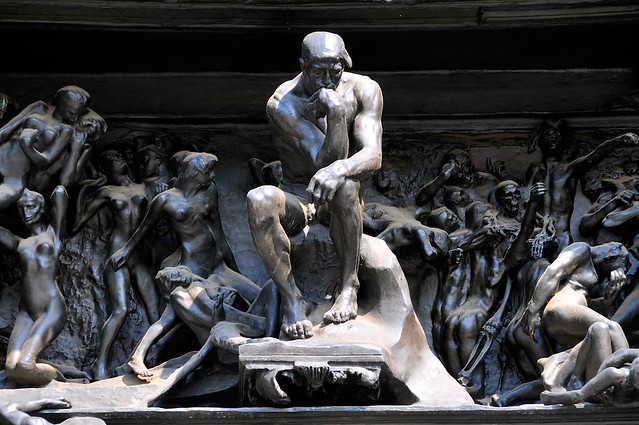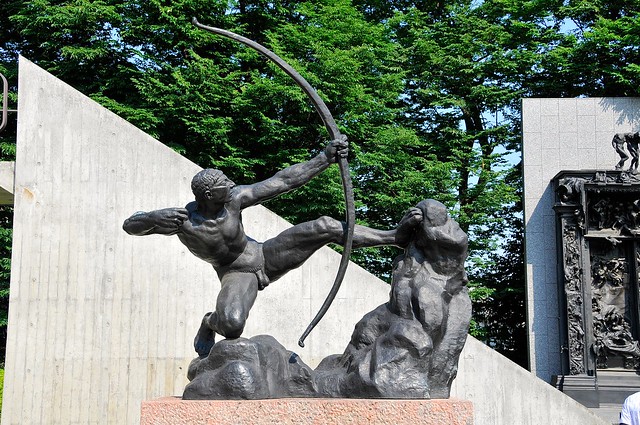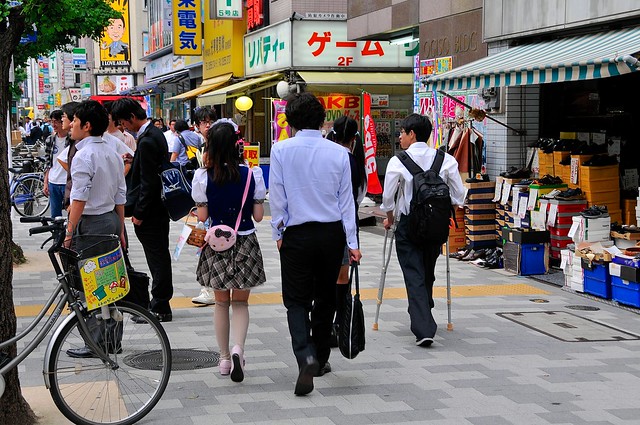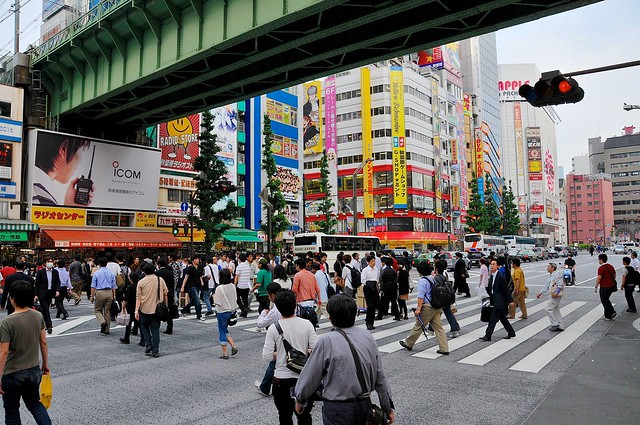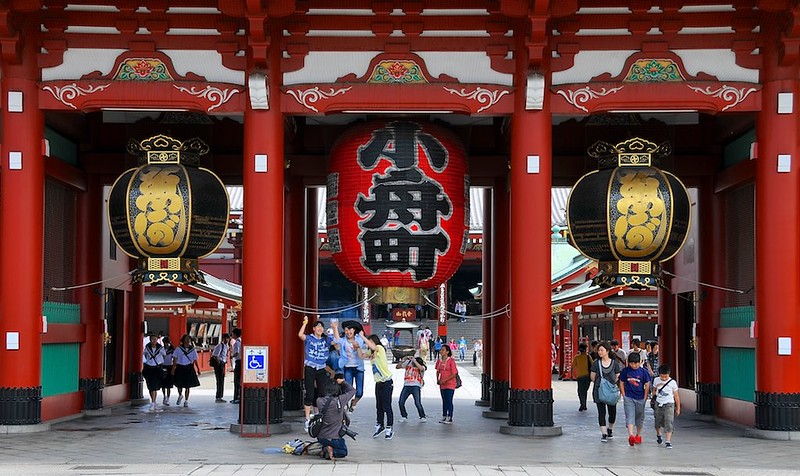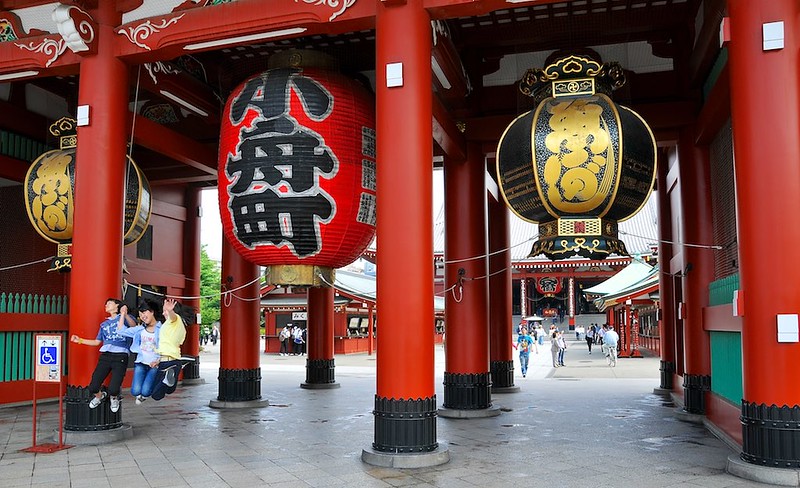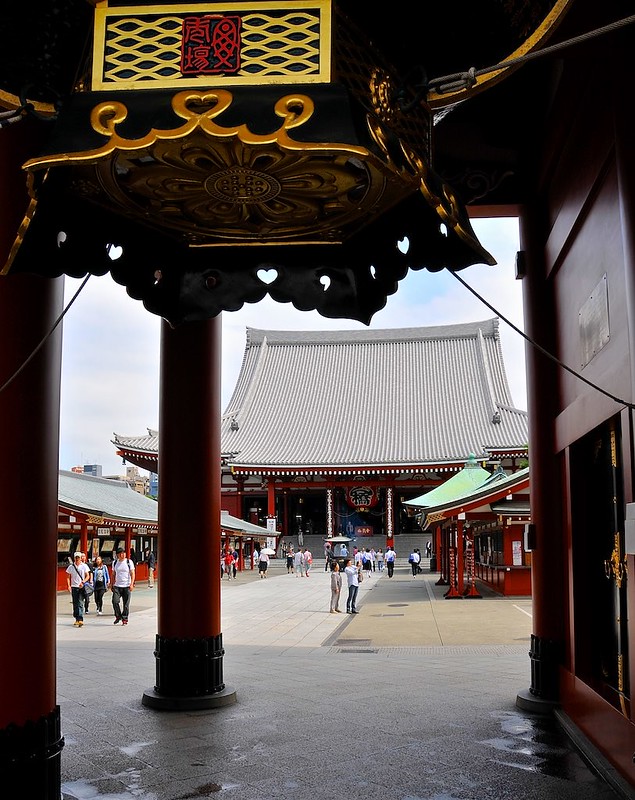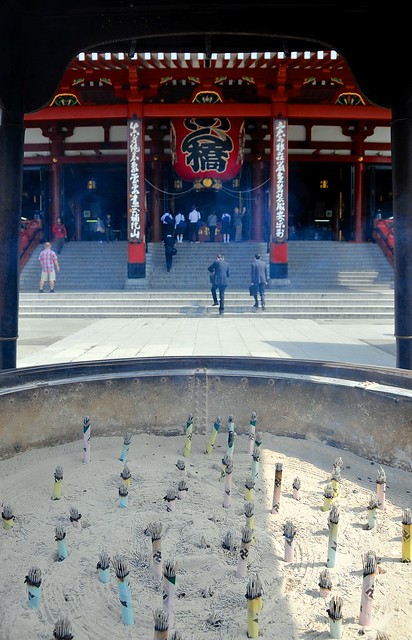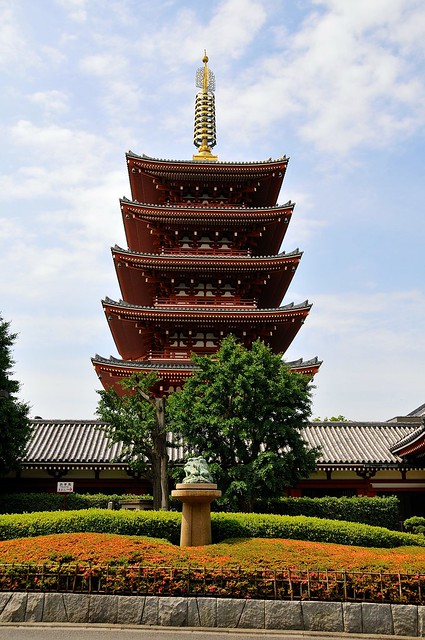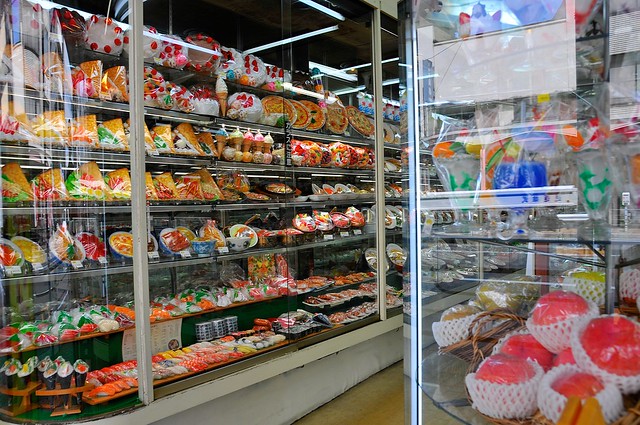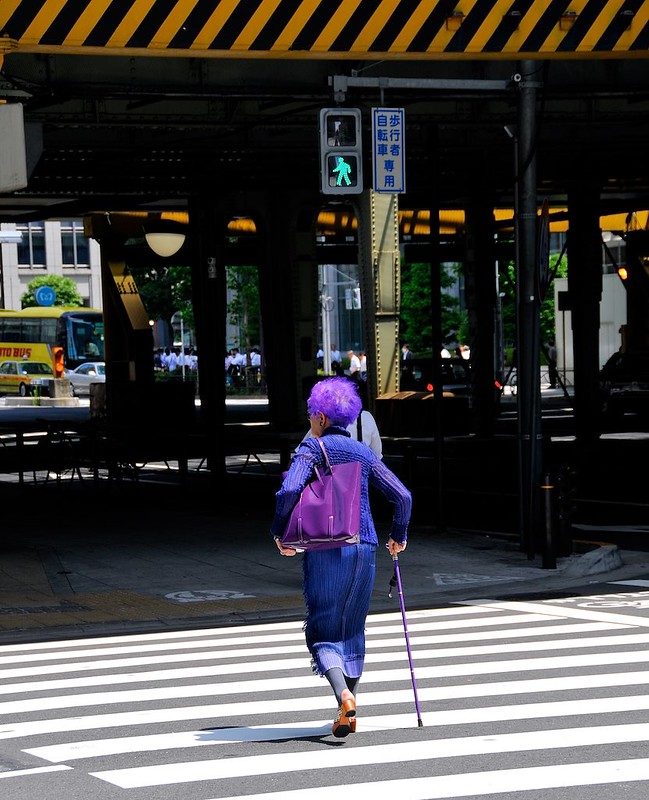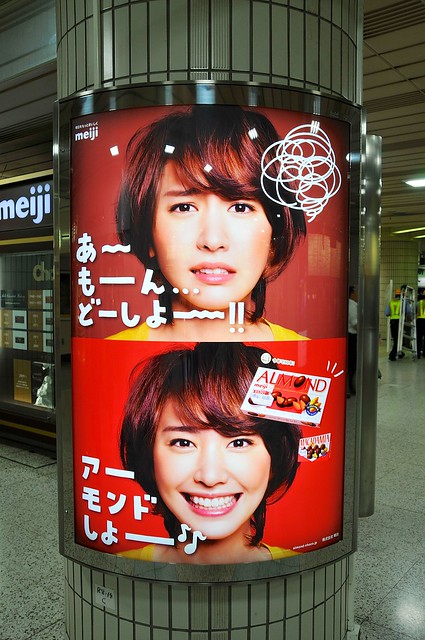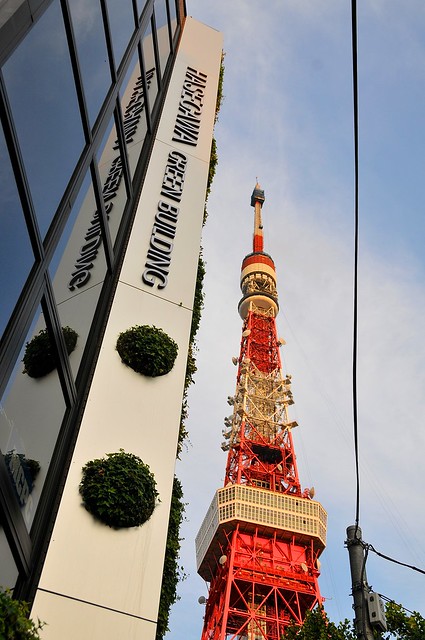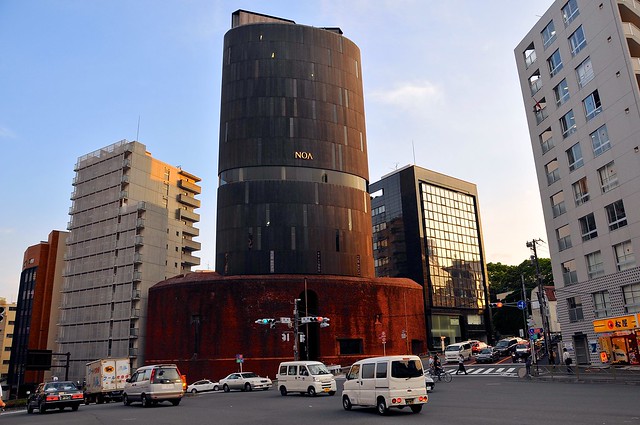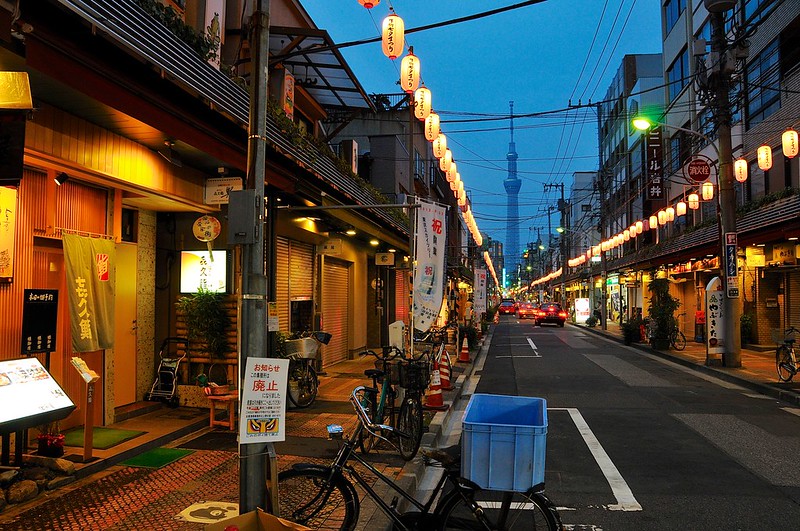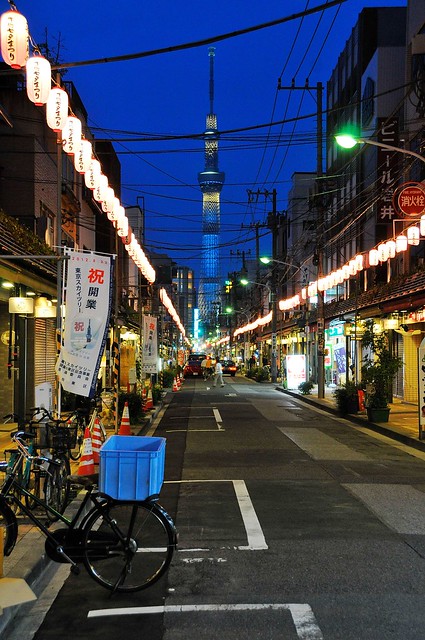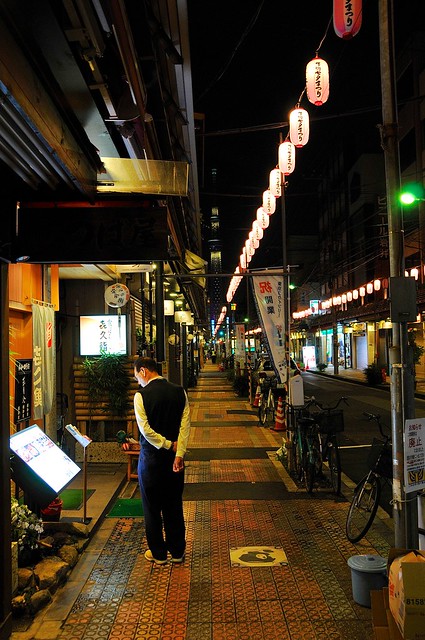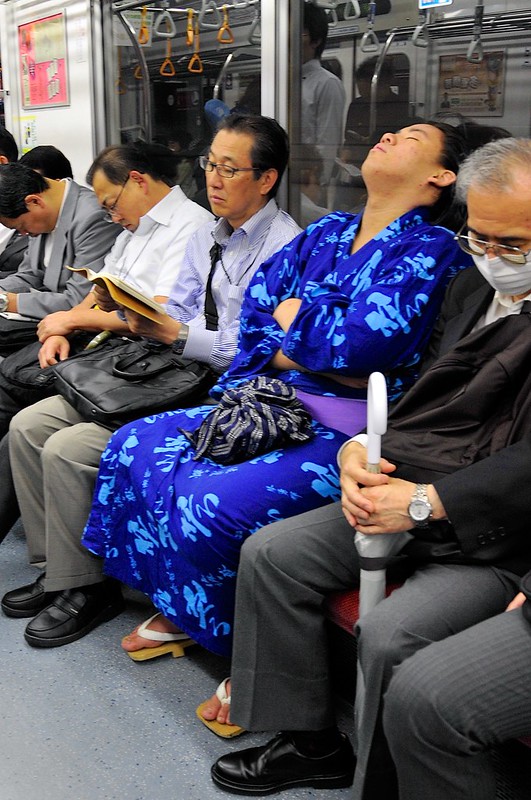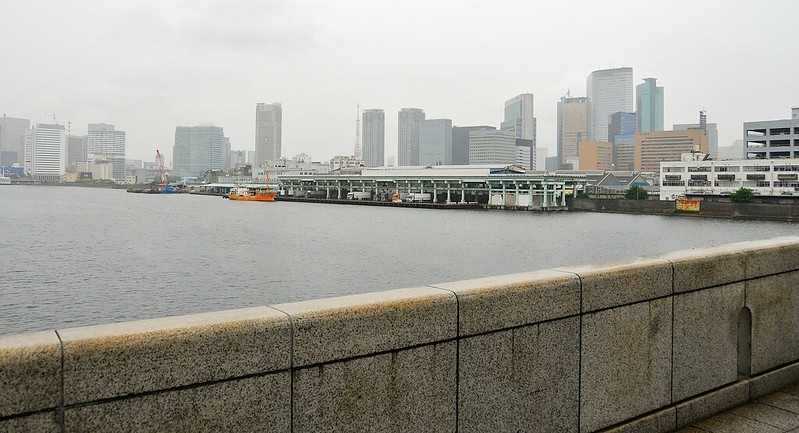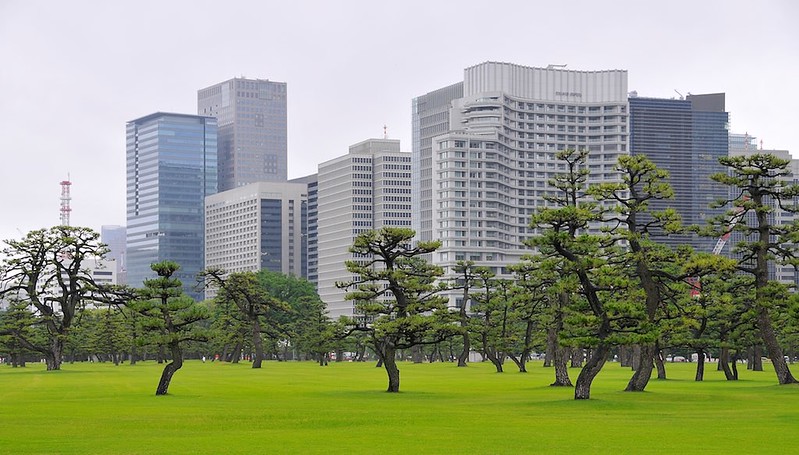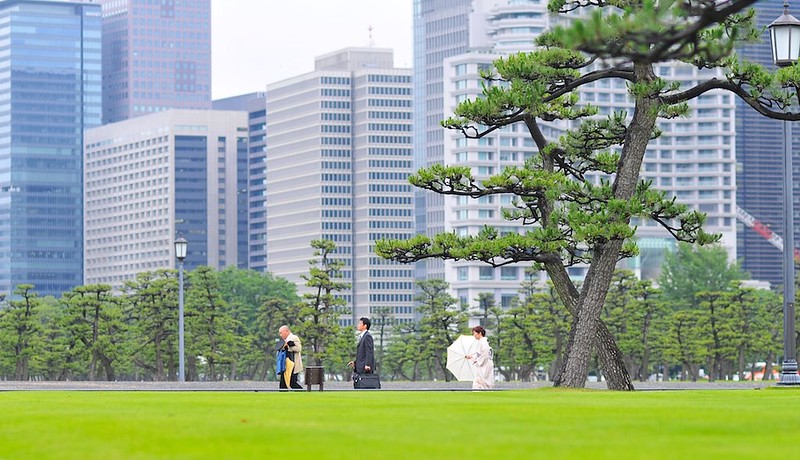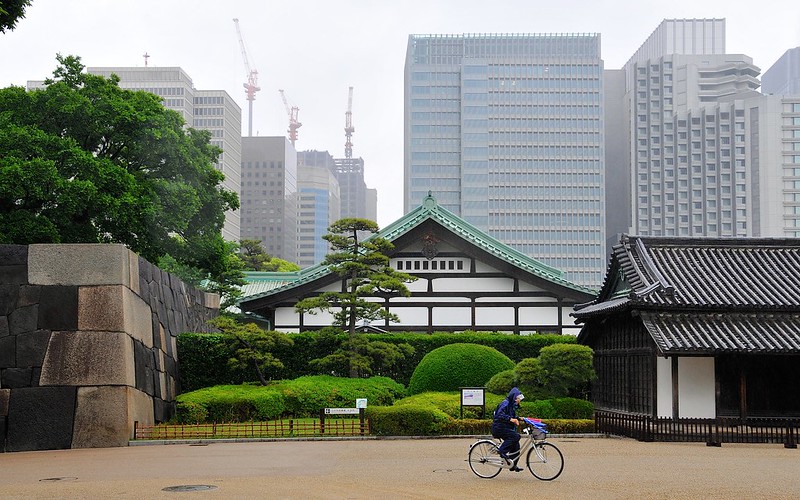Tsukiji Fish Market
On my third day in Tokyo I woke up at around 3:30. This was my chance to visit Tsukiji and take the tour—I guess jet lag is good for some things, especially for non-morning people like me.It will seem strange to many that the subways in Tokyo do not run 24 hours per day. Instead, the lines close around midnight and open around 5:00. As you need to get in line for Tsukiji tickets before they start giving out vests at 5:00, you can't use public transit to get to Tsukiji.
I ended up walking from Asakusa to Tsukiji. According to Google, it's about a 6km walk, taking 1:15. Taxis in Tokyo are hugely expensive, and I like walking, so this was OK with me.
I was feeling a little nervous as I got close to the entrance, as it was after 4:30 and I was afraid I would be too late to secure a place. It turns out that I was fine, as there were only about 40 or 50 people lined up ahead of me in front of the entrance gates.
At about 5:00 they let you into a waiting room, and herd you into two lines. Each line gets a different coloured vest, corresponding to the two sequential tours they let in. When I went they let in 150 tourists per day, but that has been scaled back to 120 tourists per day. Although this may make it more difficult to get a spot, it probably helps the experience since my group was very cramped inside the Tuna auction area.
The Tuna auctions may or may not be what you expect. Basically, what you see is a bunch of frozen Tuna sitting on the concrete floor of a nondescript warehouse (contrary to popular belief, almost all tuna is frozen—even in Japan—while in the US it's actually illegal to sell sushi fish that hasn't been frozen). The tails of the tuna are cut, and buyers walk around with metal hooks to lift up the tuna and explore their flesh. There is no commentary or explanation, so you don't really know what they are looking for. You will see a few auctions but in all honesty it's impossible to see who is bidding on what, or how much is being bid. All of this will be seen from a narrow viewing area jammed with tourists, all of whom are intent on taking pictures and jockeying for viewing positions. After waiting 20 years for this experience, it was a bit of a disappointment.
Once
the tuna auction tour is done (it takes maybe 20 minutes), you're let
loose on the market grounds. You can't visit the wholesale areas until
9:00—about two and a half hours later—so most people go to one of the
sushi shops located near the west entrance. These have limited menus in
English and maybe a couple of other languages, and you can also buy
sashimi fish in plastic containers, too.
 |
| Multiple languages? How un-Japanese. |
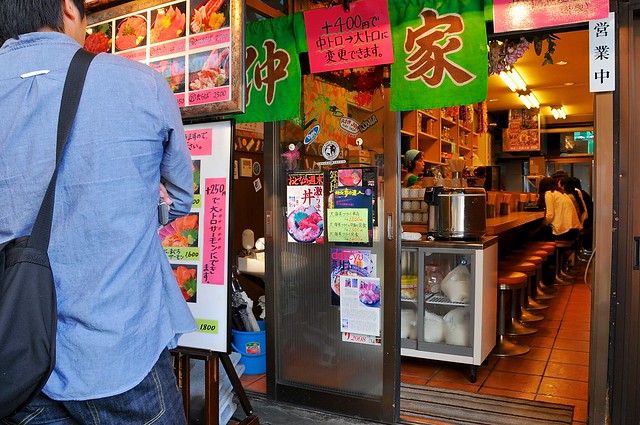 |
| There are rows of tourist restaurants near the west entrance. These are some of the cheaper tourist restaurants. |
Most
of what you see in the wholesale area is (frozen) tuna, but you do see
some other seafood, too. It's not that exciting, though.
 |
| The wholesale market. |
The verdict
In all honesty, Tsukiji is pretty over-rated. You don't see that much during the early-morning auctions, unless you like to see a lot of frozen fish. In my opinion, there are many other fish markets that are much more interesting. For example, the Jagalchi fish market in Busan and the Aberdeen market in Hong Kong both offer a much wider variety of live fish. Heck, even the Rialto Market in Venice will be more interesting to most people. And just about any wet market that caters to the retail market (as opposed to the wholesale trade market) will have a much wider variety of fresh fish (and other comestibles, from meats to vegetables) for sale.On the other hand, if you don't mind getting up early in the morning and making your way down there, there's no real reason not to visit Tsukiji. It's free, the auction occurs so early that it won't interfere with anything else you're planning to do that day, and even if you stay until the rest of the market opens to the public at 9:00, you'll still be done by 10:00. So there's no reason not to do it, just don't have extravagant hopes, and don't beat yourself up if you aren't able to see it.
A couple of helpful links for planning a Tsukiji visit:
http://www.japan-guide.com/e/e3021.html
http://tokyocheapo.com/entertainment/9-things-you-should-know-before-visiting-the-tsukiji-fish-market-tuna-auction/http://tokyocheapo.com/entertainment/9-things-you-should-know-before-visiting-the-tsukiji-fish-market-tuna-auction/
Ueno Park
Ueno Park is home to the National Museum of Western Art as well as a large pond which is sometimes full of lotuses. I entered Ueno Park from the east, and after walking around a bit I suddenly knew the if I went down a courtyard and turned left, I would see Rodin's Gates of Hell. And so I did. It's a very weird feeling to have that sense of familiarity. It was also a little saddening to realize how much more pleasure I took in the experience twenty years ago. Of course, that was my first real experience outside of North America, and my first experience of relatively independent travel (my grandmother wasn't very mobile, even then, so I went to most places by myself), but in many ways it's much harder to impress me now.Akihabara
South of Ueno Park is Akihabara, the famous otaku (geek) enclave where you can find maid cafes, shops full of manga, and all sorts of things we would associate with weird Japanese culture. Of course, this also means a lot of pornography.Japan's approach to porn is very weird. On the one hand, they censor depictions of genitals, pixellating them out. On the other hand, a lot of their porn is very hardcore and very weird. In part, I suspect that they sexualize a lot of thing (like tentacle porn) precisely because of the prohibitions on more straightforward sex—a penis in the vagina must be censored, but a tentacle in the ass is just fine.
More problematic is the public acceptance of the intense sexualization of children, and even infants. You can go into any convenience store and find magazines dedicated to showing overdeveloped 13-year-olds in tiny bikinis, with both their age and cup size prominently advertised. In Akihabara you can find DVDs of pre-pubescent models in bikinis, conveniently located in the non-porn section. I realize there is a certain amount of hypocrisy in my saying this, as it is the West and not Japan that has normalized hairless pudenda and while sharing the Japanese fetishization of schoolgirl uniforms, but Japan goes beyond the pale when you can find manga showing toddlers and babies being penetrated and sexually abused. Despite the widespread nature of this kind of imagery, however, Japanese politicians, police, and experts always describe themselves as confounded when real-life cases of sexual abuse come to light. When I lived there, there was a case where a pedophile who had been in jail was released, and promptly re-offended. When asked why he didn't receive any treatment for pedophilia while in jail, the answer was that Japan doesn't have any experience with that kind of problem, so they didn't know how to treat it (or even diagnose it).
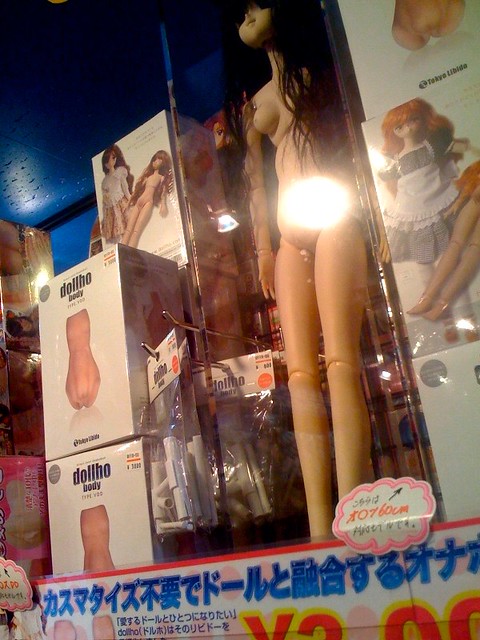 |
A Barbie-doll-size masturbator: the Dollho. Nothing weird about that.
|
 |
Pre-pubescent girls in bikinis. Seems legit.
|
 |
| A dog waits outside for its owner. Dogs in Japan pay not attention to strangers, even if you bend down to pet them. |
Trains are expensive: I'm taking the bus
As I said earlier, trains are expensive in Japan. A ticket from Tokyo to Kyoto would be ¥13,720—about $140, at the time. Instead, I decided to take an overnight JR bus. JR buses have the convenience of departing and arriving at train stations, there are frequent departures, and I hoped that I would be able to sleep overnight. The bus ticket from Tokyo station to Kyoto station was ¥8,100, and if you factor in saving a night's accommodation, then it's less than half the price of taking the train. The bus was fairly full, but the experience was fairly pleasant and I was able to sleep pretty well. I'm not aware that we made any stops on the way to Kyoto.
JR isn't the cheapest bus service, and it probably isn't the best, either. There's a private bus company called Willer Express that offers service along the same route from around ¥4,600. I used them on my Osaka-Hiroshima trip and was very pleased.
JR isn't the cheapest bus service, and it probably isn't the best, either. There's a private bus company called Willer Express that offers service along the same route from around ¥4,600. I used them on my Osaka-Hiroshima trip and was very pleased.
